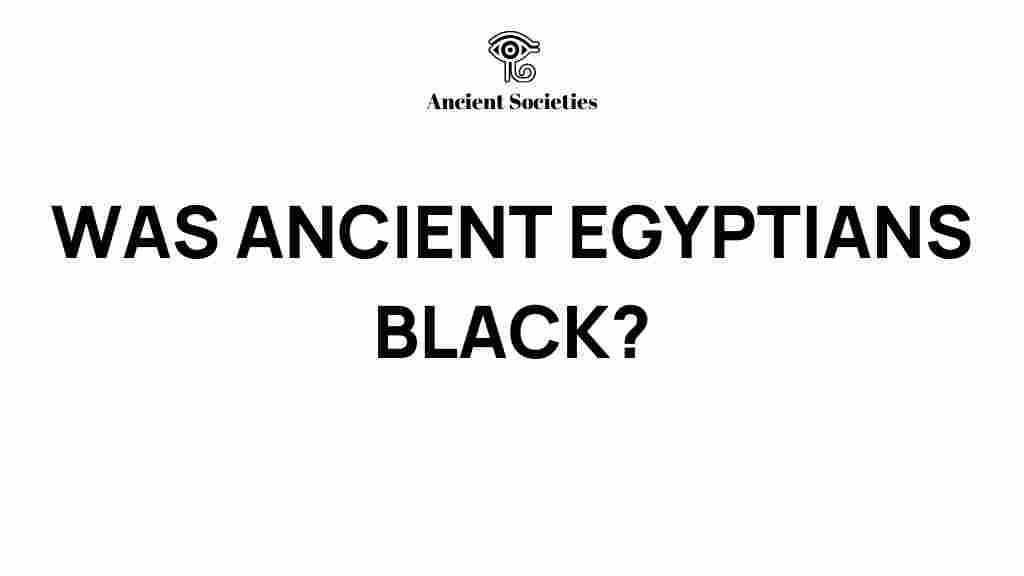Unraveling the Mystery: Were the Ancient Egyptians Black?
The question of the racial identity of the Ancient Egyptians has sparked considerable debate among historians, archaeologists, and scholars of history and culture. This inquiry is not merely academic; it touches on issues of identity and ethnicity that resonate deeply in contemporary discussions about race and representation. In this article, we will explore the Nile Valley civilization, its diverse populations, and how archaeological findings contribute to our understanding of the Ancient Egyptians.
The Geographic and Historical Context
The Ancient Egyptians thrived along the banks of the Nile River, one of the longest rivers in the world, which provided fertile land and a means of transportation. This civilization, one of the earliest and most remarkable in human history, lasted thousands of years, from around 3100 BCE until Alexander the Great’s conquest in 332 BCE. The Nile Valley was not only a geographical entity but also a cultural cradle that fostered a unique identity.
Throughout its history, Egypt experienced various waves of migration and invasion, which contributed to the diversity of its population. The intermingling of different groups—Nubians from the south, Semitic peoples from the east, and later Greco-Roman influences—shaped the cultural fabric of Ancient Egyptian society.
Race and Identity in Ancient Egypt
Understanding the concept of race as it pertains to the Ancient Egyptians requires us to recognize that ancient societies did not categorize individuals in the same way modern societies do. The modern racial categories of Black, White, and others are largely products of socio-political contexts that developed much later in history. In Ancient Egypt, identity was more fluid and often based on culture, language, and geography rather than strict racial definitions.
- Ethnicity: The Ancient Egyptians identified primarily with their culture and shared history rather than with race.
- Cultural Practices: Their religion, art, and language fostered a strong sense of identity among the people.
- Geographic Influence: The Nile Valley attracted various peoples, contributing to a melting pot of ethnicities.
The Role of Archaeology in Understanding Ancient Egyptian Identity
Archaeological research provides invaluable insights into the demographics of Ancient Egypt. Excavations of burial sites, settlements, and artifacts reveal a complex society with a varied population. Studies of mummies and skeletal remains have also shed light on the genetic makeup of the Ancient Egyptians.
Some key archaeological findings include:
- Mummification Practices: The elaborate burial customs point to a belief system that transcended ethnic differences.
- Artifacts: Tools, pottery, and artworks depict a society engaged in trade and cultural exchange with neighboring regions.
- Genetic Studies: Recent DNA analyses indicate that the populations of Ancient Egypt were diverse, with influences from Sub-Saharan Africa, the Near East, and Europe.
Art and Representation
Art plays a crucial role in understanding the Ancient Egyptians and their self-representation. The depiction of skin tones in art often reflects cultural and symbolic meanings rather than exact racial distinctions. For instance, ancient Egyptian paintings typically used reddish-brown for males and yellow for females, which were not necessarily representative of actual skin color but rather symbolic of gender roles and societal norms.
Controversies and Misconceptions
The narrative surrounding the race of the Ancient Egyptians has often been clouded by misconceptions and political agendas. Some argue that the portrayal of Ancient Egyptians as predominantly Black or African is an attempt to reclaim the African heritage of this civilization, while others claim that emphasizing this identity overlooks the diverse influences that shaped ancient Egyptian culture.
Key points to consider in this discourse include:
- Eurocentrism: Historical narratives have often marginalized African contributions to civilization.
- Nationalism: Various groups have sought to claim the Ancient Egyptians as part of their national or racial identity.
- Scientific Evidence: Ongoing research continues to evolve our understanding of the ethnic diversity in Ancient Egypt.
Modern Implications of Ancient Egyptian Identity
The question of whether the Ancient Egyptians were Black is not merely an academic exercise; it has significant implications for modern discussions on race and identity. In a world where racial identity continues to influence social dynamics, understanding the complexities of ancient identity can help foster a more nuanced perspective on contemporary issues.
For instance, recognizing the multicultural aspects of Ancient Egyptian society can promote greater appreciation for African contributions to world history and challenge reductive narratives that seek to define civilization within narrow racial parameters.
Troubleshooting Common Misunderstandings
As we navigate the conversation around the race of the Ancient Egyptians, it is essential to address common misunderstandings:
- Misconception: All Ancient Egyptians were Black.
- Clarification: Ancient Egypt was a melting pot of various ethnicities and identities.
- Misconception: The skin tone depicted in art is an accurate representation of race.
- Clarification: Artistic representations were symbolic and do not directly correlate to actual skin color.
- Misconception: Modern racial categories apply to ancient peoples.
- Clarification: Ancient societies had different ways of identifying and categorizing their populations.
Conclusion
The identity of the Ancient Egyptians is a complex tapestry woven from threads of history, culture, and ethnicity. While the question of race remains a contentious topic, it is crucial to approach it with an understanding of the historical context and the diversity that characterized the Nile Valley civilization. As archaeology continues to unveil new findings, our understanding of the Ancient Egyptians will evolve, reflecting the multifaceted nature of their identity.
For further reading on the archaeology of Ancient Egypt, you can explore this comprehensive resource. Additionally, to understand more about race and identity in ancient civilizations, check out this insightful article.
In conclusion, the question of whether the Ancient Egyptians were Black is not just about race; it is about recognizing the rich cultural heritage and diverse identities that have shaped this remarkable ancient civilization.
This article is in the category Archaeology and created by AncientSocieties Team
